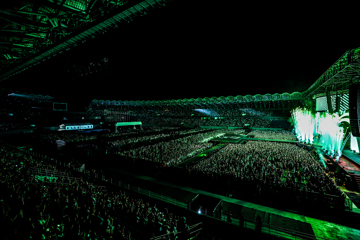What We Do In The Digital Shadows: The Secret World Of Shock Sites
Don't throw shade, more people than you think have been to the dark side of these never-unseeable online trends.
I have a confession to make: I never saw the infamous 2007 viral video popularly known as Two Girls One Cup. Not first hand, at least.
That might not put me in the minority today - and if you're not familiar with it, a word of advice: don't google it at work. But just over a decade ago, when this now notorious poop-porn first BM'd its way onto the internet, it was arguably the most dominant pop-culture touchstone of the digital age to date.
Originally known by the charming title Hungry Bitches, the disturbing piece of scatological erotica featured two women getting frisky over a whipped-shit smoothie (like I said, don’t google it at work). But after entering the zeitgeist, it somehow became something more: a bizarrely galvanising shared experience. People around the world collectively subjected themselves to this never-unseeable faecal fiesta, and even wore the ordeal as a badge of honour. Somehow, a piece of extreme kink became a handy social icebreaker, a witty punchline, and a patch of common ground on a scale few pieces of online ephemera had ever achieved before it.
And while I never had the dubious pleasure of witnessing 2G1C for myself, I still kind of feel as if I did. Because if anything could be said to have surpassed the skid-smeared reach of those two poor girls and their one terrifying cup, it would arguably be the genre of digital media this inglorious porn clip gave rise to: the reaction video. Purists will say the first true examples – the Scary Maze Game reactions – predate the Two Girls One Cup variety by a year. But the sheer volume of Two Girl reaction vids makes them a watershed phenomenon in their own right. And there’s something remarkably uncanny about the emotional vector replicated, almost verbatim, video after video, as the knee-jerk responses to this minute of hardcore horror were documented.
It begins with an incredulous gasp, followed by a few seconds of slack-jawed incomprehension. Then the revulsion builds and the pupils dilate, until the harrowing scene sends the viewer into a scrambling, near-hysterical panic.
Don't miss a beat with our FREE daily newsletter
There’s a good reason why these reaction videos are so strikingly similar, which also reveals why the global ascendancy of this shock porn filth-fest isn’t as inexplicable as it might appear. According to forensic psychologist Maycon Merlo, videos like Two Girls One Cup can highjack the brain’s most primitive responses.
“It triggers something known as the ‘Three Fs’: Fight, Flight and Freeze,” Merlo explains. “And this is controlled by one of the main compositions of the brain, the amygdala. This part of the brain controls sensations of fear, anxiety, pleasure and other important instincts for survival. All mammals have these same responses hardwired into the nervous system, which activate the release of neurotransmitters such as dopamine.”
These naturally occurring substances can quicken the pulse, sharpen the senses, and create feelings of exhilaration. But whereas our tree-dwelling ancestors used these chemical cues to avoid danger, modern humans process these responses in an altogether different way. Much like the rush we get from a roller-coaster or a scary movie, in the absence of genuine threat, these survival reactions can give us an appealing high. “We have a highly evolved prefrontal cortex, so we are able to intelligently rationalise these responses. And we also have empathy – we can mirror and engage with the emotional responses of others in highly imaginative ways,” Merlo adds.
In the decade since Two Girls One Cup first shook unsuspecting viewers into a giddy, adrenaline-fuelled frenzy, many similar memes have followed in its dank footsteps, including seminal classic Blue Waffle and the truly traumatising One Man One Jar (google at your own peril). But back when smartphones were dumb Blackberrys, social media was MySpace, and early adopters were only just figuring out how their online personas intersected with their day to day reality, exploring this type of media was an oddly social affair; digital content only went viral by word of mouth. Today, hacking our amygdala is a more private activity, and to that end, behind closed doors, there's a veritable smorgasbord of digital media geared towards hotwiring our neurochemistry.
And not always to give us a creeped-out buzz — some types of content have been found to instil a sense of tranquility and calm. One surprisingly in-demand genre are videos involving cyst excisions and similar dermatological surgeries. The popularity of these clips is mind-boggling: the videos on Dr Sandra Lee’s Dr Pimple Popper channel, one of YouTube’s most popular in this subculture, have been viewed more than a billion times. With such a ratings bonanza beckoning, it's little surprise that Lee recently landed her self a TV show in her native US. True devotees of Lee's surgical clips are proud to call themselves "popoholics," but the appeal of this content seems to be a cross-cultural phenomena, with copycat accounts now active from Asia to Australia, racking up the clicks in their hundreds of thousands.
There’s a similarly ferocious demand for ASMR content, which activates the brain’s Autonomous Sensory Meridian Response. In addition to de-stressing effects, fans also report tingly, deeply relaxing sensations in the scalp, neck and face. These sound driven vids, of which there are more than 13 million on YouTube, feature the soothing strains of whispering, stroked surfaces, gentle tapping and other subtle noises like towels being folded, paper being crumpled, hair being brushed, and even microphones being licked. Several studies have explored the effects of these videos and found them to have measurable therapeutic results including reduced insomnia and even lower blood pressure. Such is the addictive power of ASMR, in fact, that it is now being tapped by big business. Last month, McDonalds recruited the dulcet tones of John Goodman for an ad strategically crafted for maximum ASMR effect, although it was dubbed "creepy" by viewers unmoved by its sonic tricks (and honestly, same).
How the web went dark
There is, of course, a yin to ASMR and popoholism's yang. As far back as the mid-1990s, websites began emerging, most notably the now-defunct rotten.com, which catered to an underground yet thriving community of people in search of the macabre and disturbing. Most of these early sites, constrained by the limits of dial-up modems, largely featured images of gruesome crime scenes and fatal accidents. However, in recent years, as super-fast broadband has made accessing videos effortless, the scope of media available on shock sites has expanded. Since launching in 2008, bestgore.com — which is self-described as a "reality news site" — has taken up the mantle of rotten.com as the most visited purveyour of shock material online, with an estimated 5-million visitors logging on a month. There's a vast variety of viscera on offer at this site and others like it, from car accidents to suicides, but perhaps the most disturbing examples being widely distributed are of jihadi prisoner beheadings, commonly of Western hostiages.
But as the ubiquity of this often controversial and divisive conten has increased, so too has the scale of the public taboo surrounding it. In 2013, for example, entertainment news site TMZ found themselves on the sharp end of a social media backlash when they published CCTV footage of the firey car crash in which actor Paul Walker died. At the same time, this footage was being widely distributed and watched on clandestine shock sites, free from the public furore. It’s hardly a stretch to grasp why a penchant for such graphic viewing isn't something many people are prepared to admit to, although the colossal traffic these portals attract means that if you’re not watching yourself, it’s highly likely you know someone who is.
"Seeking a true glimpse of our mortal reality, no matter how goulish or bleak, seems to satisfy an ages-old quirk of human consciousness: a need to look our mortality in the eye."
But is this fascination with death and depravity really such an anathema?
From the Roman gladiatorial battles to the public tortures of the Middle Ages, the scandalising Penny Dreadfuls of Victorian London to the streaming era's True Crime obsession, both past and present are littered with examples of morbid curiosity and gore-fuelled entertainment. Much like Two Girls One Cup, the appeal can be linked to the yummy rush of stimulants provided by the brain’s instinctual reflexes, but this preoccupation also seems anchored to a less corporeal quality; something philosophical and existential.
In centuries past, the 'memento mori' — a reminder that all life must eventually die — was an idée fixe found across artistic and spiritual traditions around the world. Thanks to our present day privileges, sophisticated medicines and higher standards of living, death has become a far less conspicuous presence in the everyday. And perhaps it's the desensitising influence of blockbuster body counts and fictionalised bloodbaths, but seeking a true glimpse of our mortal reality, no matter how goulish or bleak, seems to satisfy an ages-old quirk of human consciousness: a need to look our mortality in the eye.
It may well be an innate curiosity, indeed a part of our anatomy as well as our humanity, but fear of judgment has nonetheless driven these online habits into the shadows. And not least because of the dangerous intent and skewed morality an interest in such horrific viewing implies. However, as Maycon Merlo explains, deranged psychopaths are unlikely to be tuning in. “Psychopathic and sociopathic behaviours are the result of an absence of emotion and empathy, so the empathetic relationship that triggers the Three Fs response just isn’t there. For a psychopath, watching a video of a public execution would be as affecting as watching someone brush their teeth.”







